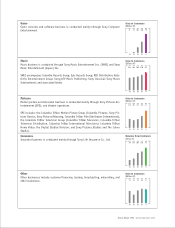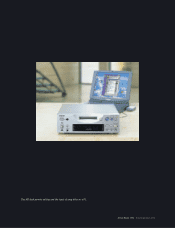Sony 1998 Annual Report Download - page 26
Download and view the complete annual report
Please find page 26 of the 1998 Sony annual report below. You can navigate through the pages in the report by either clicking on the pages listed below, or by using the keyword search tool below to find specific information within the annual report.[24] Sony Corporation Annual Report 1998
« Electronic components and other »
Semiconductors
In response to the fast pace of digitization in audiovisual equipment, Sony stepped up develop-
ment and production of the key devices essential to differentiate its products. During the year,
sales grew for LSIs used in video CD, MD products, digital camcorders, and cellular phones due to
higher demand for these products. Sales of high-resolution CCDs for digital still cameras also
performed well. In the memory business, which was negatively affected by the weakness in the
PC market, Sony concentrated on higher value-added products such as ultra-speed SRAM (static
random access memory) chips. To meet rising demand for semiconductor lasers, essential ele-
ments of CD, DVD and other optical disk equipment, Sony newly constructed a fully integrated
production system, which conducts all production operations from wafer processing to final
assembly.
To preserve a competitive edge in the semiconductor business while at the same time con-
trolling capital expenditures, Sony entered into strategic alliances during the year. One alliance
covers the development, design and production of next-generation system LSIs with Fujitsu
Limited. These devices are critical to making electronic equipment smaller while raising perfor-
mance and cutting power consumption. Preparations are going forward for the start of mass
production in the fall of 1999.
Liquid Crystal Display (LCD)
During the year, high-temperature polycrystalline silicon (Poly-Si) thin-film transistor (TFT)
LCDs with higher transparency and picture quality, particularly applicable in view-finders of
camcorders and projectors, recorded favorable sales. To win out against competition to develop
better LCDs, resulting from a trend toward LCD panels with greater resolution and brightness,
Sony is continuing its efforts to streamline all processes including shortening the time taken for
development, by establishing a comprehensive system which covers design, development, and
production. In the low-temperature, Poly-Si TFT LCD field, in which demand is expected to
increase for applications such as monitors on camcorders and information-related equipment,
Sony has succeeded as one of the first companies to bring such products to market. Sales for
these products are steadily expanding. Furthermore, Sony and Toyoda Automatic Loom Works,
Ltd. of Japan have created a 50-50 joint manufacturing venture in this field, ST Liquid Crystal
Display Corp. The company plans to begin mass production in the spring of 1999.
Electronic Components
Sony develops and produces such key electronic components as optical pickups and spindle
motors for CD, MD and DVD applications, as well as magnetic heads for digital VTRs and data
storage systems.
In the optical pickup sector in particular, Sony maintains a worldwide market share exceed-
ing 50%. During the year, output climbed as demand grew for video CD and MD products. In
addition, Sony developed an optical pickup that can read CD-ROMs at a maximum 24X speed and
perform high-speed writing to CD-R and CD-RW disks.
In the field of spindle motors for CD and DVD equipment, Sony introduced a new product
that attenuates the vibrations from a rapidly spinning disk to ensure the stable retrieval of data.
Another newly developed product is a high-density recording head for the HiFD high-capac-
ity floppy disk system, which is planned for release in the near future.
Lithium-Ion Batteries
As a small, lightweight, rechargeable battery, lithium-ion batteries are in increasing demand as
the market for portable electronic equipment grows. A pioneer in this field, Sony continued to
respond to diversifying customer needs by ensuring a stable supply of batteries and expanding
its lineup for cellular phones and other applications. However, sluggishness in the PC market
adversely affected the demand for these types of batteries during the year.
























